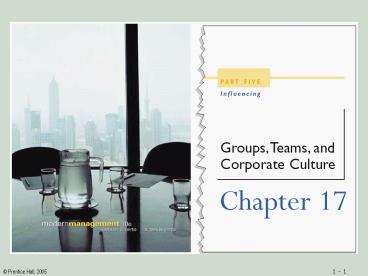Modern Management, 10e Certo - PowerPoint PPT Presentation
1 / 24
Title:
Modern Management, 10e Certo
Description:
1. A definition of the term group as used in the context of management ... Leaders' reactions to critical incidents and organizational crises ... – PowerPoint PPT presentation
Number of Views:195
Avg rating:3.0/5.0
Title: Modern Management, 10e Certo
1
(No Transcript)
2
Objectives
- 1. A definition of the term group as used in the
context of management - 2. A thorough understanding of the difference
between formal and informal groups - 3. Knowledge of the types of formal groups that
exist in organizations - 4. An understanding of how managers can
determine which groups exist in an organization - 5. An appreciation for what teams are and how to
manage them - 6. Insights into managing corporate culture to
enhance organizational success
3
Groups
- Group is any number of people who
- (1) interact with one another
- (2) are psychologically aware of one another
- (3) perceive themselves to be a group
- Why managers should study groups
- 1. Exist in all kinds of organizations
- 2. Form in all facets of organizational existence
- 3. Cause either desirable or undesirable
consequences - 4. Raise the probability of causing desirable
consequences
4
Kinds of Groups in Organizations
- Formal Groups
- Kinds of Formal Groups
- Command groups
- Task groups
5
Kinds of Groups in Organizations
6
Kinds of Groups in Organizations
- Formal Groups (continued)
- Examples of Formal Groups
- Committees
- Reasons for establishing committees
- 1. Allow organization members to exchange ideas
- 2. Generate suggestions and recommendations
- 3. Develop new ideas for solving existing
organizational problems - 4. Assist in the development of organizational
policies - Why Managers Should Use Committees
- Improve quality of decision making
- Encourage expression of honest opinions
- Increase members participation in
decision-making - Ensure representation of important groups in
decision-making process
7
Kinds of Groups in Organizations
8
Kinds of Groups in Organizations
- Formal Groups (continued)
- Examples of Formal Groups (continued)
- Committees (continued)
- What Makes Committees Successful
- Procedural Steps
- Define goals clearly, preferably in writing
- Specify authority
- Determine optimum size
- Select chairperson
- Appoint permanent secretary
- Distrubute agenda and support material before
meeting - Start meetings on time-announce ending time at
outset - People-Oriented Guidelines.
- Rephrasing ideas already expressed
- Bringing all members into active participation
- Stimulating further thought by members
- Groupthink
9
Kinds of Groups in Organizations
- Formal Groups (continued)
- Examples of Formal Groups (continued)
- Work Teams
- Special-Purpose and Self-Managed Teams
- Stages of Formal Group Development
- The Acceptance Stage
- The Communication and Decision-Making Stage
- The Group Solidarity Stage
- The Group Control Stage
- Members function as a unit
- Members participate effectively in group effort
- Members are oriented toward a single goal
- Members have equipment, tools, and skills
necessary to attain goals - Members exchange suggestions, opinions, and
information
10
Kinds of Groups in Organizations
- Informal Groups
- Kinds of Informal Groups
- Interest groups
- Friendship groups
- Benefits of Informal Group Membership
- 1. Perpetuation of social and cultural values
- 2. Status and social satisfaction
- 3. Increased ease of communication
- 4. Increased desirability of the overall work
environment
11
Kinds of Groups in Organizations
12
Managing Work Groups
- Determining Group Existence
- Sociometric Analysis
- Applying the Sociogram Model
- Understanding the Evolution of Informal Groups
- Homans Model
- Applying the Homans Model
13
Managing Work Groups
14
Managing Work Groups
15
Teams
- Groups Versus Teams
- Group consists of any number of people who
- Interact with one another
- Are psychologically aware of one another
- Think of themselves as a group
- Team is a group whose members
- Influence one another toward the accomplishment
of objective(s) - Types of Teams in Organizations
- Problem-Solving Teams
- Self-Managed Teams
- Cross-Functional Teams
16
Teams
17
Teams
- Stages of Team Development
- Forming
- Storming
- Norming
- Performing
- Adjourning
18
Teams
- Team Effectiveness
- People-related steps
- 1. Trying to make the teams work satisfying
- 2. Developing mutual trust among team members and
- between the team and management
- 3. Building good communication
- 4. Minimizing unresolved conflicts and power
struggles within the team - 5. Dealing effectively with threats toward and
within the team - 6. Building the perception that the jobs of team
members are secure
19
Teams
20
Teams
- Team Effectiveness (continued)
- Organization-related steps
- 1. Building a stable overall structure team
members view as secure - 2. Becoming involved in team events and
- demonstrating interest in team progress and
functioning - 3. Properly rewarding and recognizing teams for
accomplishments - 4. Setting stable goals and priorities for the
team
21
Teams
- Team Effectiveness (continued)
- Task-related steps
- 1. Developing clear objectives, directions, and
project plans for the team - 2. Providing proper technical direction and
leadership for the team - 3. Establishing autonomy for team and challenging
work within the team - 4. Appointing experienced and qualified team
personnel - 5. Encouraging team involvement
- 6. Building visibility within the organization
for the teams work
22
Teams
- Trust and Effective Teams
- Communicate often to team members
- Show respect for team members
- Be fair to team members
- Be predictable
- Demonstrate competence
23
Corporate Culture
- Status Symbols
- Traditions and History
- Physical Environment
- The Significance of Corporate Culture
- Mechanisms for developing and reinforcing desired
corporate culture - What leaders pay attention to, measure, and
control - Leaders reactions to critical incidents and
organizational crises - Deliberate role modeling, teaching, and coaching
- Criteria for allocation of rewards and status
- Criteria for employee recruitment, selection,
promotion, and retirement
24
- ?
Questions

